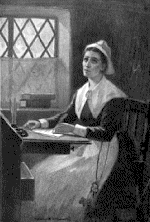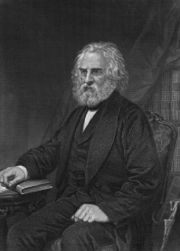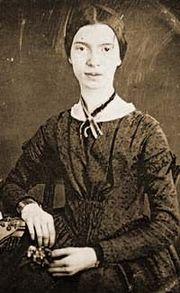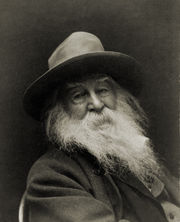Poetry of the United States
2007 Schools Wikipedia Selection. Related subjects: Poetry & Opera
| Arts of the United States |
|
Architecture |
The poetry of the United States began as a literary art during the colonial era. Unsurprisingly, most of the early poetry written in the colonies and fledgling republic used contemporary British models of poetic form, diction, and theme. However, in the 19th century a distinctive American idiom began to emerge. By the later part of that century, when Walt Whitman was winning an enthusiastic audience abroad, poets from the United States had begun to take their place at the forefront of the English-language avant-garde. This position was sustained into the 20th century to the extent that Ezra Pound and T.S. Eliot were perhaps the most influential English-language poets in the period around World War I. By the 1960s, the young poets of the British Poetry Revival looked to their American contemporaries and predecessors as models for the kind of poetry they wanted to write.
Toward the end of the millennium, consideration of American poetry had diversified, as scholars placed an increased emphasis on poetry by women, African Americans, Hispanics, Chicanos and other subcultural groupings. Poetry, and creative writing in general, also tended to become more professionalized with the growth of Creative Writing programs on campuses across the country.
Poetry in the colonies
One of the first recorded poets of the British colonies was Anne Bradstreet (1612–1672), who remains one of the earliest known women poets in English. Her poems are untypically tender evocations of home and family life and of her love for her husband. In marked contrast, Edward Taylor (1645–1729) wrote poems expounding Puritan virtues in a highly wrought metaphysical style that can be seen as typical of the early colonial period. This narrow focus on the Puritan ethic was, understandably, the dominant note of most of the poetry written in the colonies during the 17th and early 18th centuries.
Another distinctly American lyric voice of the colonial period was Phillis Wheatley, a slave whose book Poems on Various Subjects, Religious and Moral, was published in 1773. She was one of the best-known poets of her day, at least in the colonies, and her poems were typical of New England culture at the time, meditating on religious and classical ideas.
The 18th century saw an increasing emphasis on America as fit subject matter for its poets. This trend is most evident in the works of Philip Freneau (1752–1832), who is also notable for the unusually sympathetic attitude to Native Americans shown in his writings. However, as might be expected from what was essentially provincial writing, this late colonial poetry is generally technically somewhat old-fashioned, deploying the means and methods of Pope and Gray in the era of Blake and Burns.
On the whole, the development of poetry in the American colonies mirrors the development of the colonies themselves. The early poetry is dominated by the need to preserve the integrity of the Puritan ideals that created the settlement in the first place. As the colonists grew in confidence, the poetry they wrote increasingly reflected their drive towards independence. This shift in subject matter was not reflected in the mode of writing which tended to be conservative, to say the least. This can be seen as a product of the physical remove at which American poets operated from the centre of English-language poetic developments in London.
Postcolonial poetry
The first significant poet of the independent United States was William Cullen Bryant (1794–1878), whose great contribution was to write rhapsodic poems on the grandeur of prairies and forests. Other notable poets to emerge in the early and middle 19th century include Ralph Waldo Emerson (1803–1882), Henry Wadsworth Longfellow (1807–1882), John Greenleaf Whittier (1807–1892), Edgar Allan Poe (1809–1849), Oliver Wendell Holmes (1809–1894), Henry David Thoreau (1817–1862), James Russell Lowell (1819–1891), and Sidney Lanier (1842–1881). As might be expected, the works of these writers are united by a common search for a distinctive American voice to distinguish them from their British counterparts. To this end, they explored the landscape and traditions of their native country as materials for their poetry.
The most significant example of this tendency may be The Song of Hiawatha by Longfellow. This poem uses Native American tales collected by Henry Rowe Schoolcraft, who was superintendent of Indian affairs for Michigan from 1836 to 1841. Longfellow also imitated the meter of the Finnish epic poem Kalevala, possibly to avoid British models. The resulting poem, while a popular success, did not provide a model for future U.S. poets.
Another factor that distinguished these poets from their British contemporaries was the influence of the transcendentalism of the poet/philosophers Emerson and Thoreau. Transcendentalism was the distinctly American strain of the English Romanticism that began with William Wordsworth and Samuel Taylor Coleridge. Emerson, as much as anyone the founder of transcendentalism, had visited England as a young man to meet these two English poets, as well as Thomas Carlyle. While Romanticism mellowed into Victorianism in post-reform England, it grew more energetic in America from the 1830s through to the Civil War.
Edgar Allan Poe was probably the most recognized American poet outside of America during this period. Diverse authors in France, Sweden and Russia were heavily influenced by his works, and his poem " The Raven" swept across Europe, translated into many languages. In the twentieth century the American poet William Carlos Williams said of Poe that he is the only solid ground on which American poetry is anchored.
An American idiom
The final emergence of a truly indigenous English-language poetry in the United States was the work of two poets, Walt Whitman (1819–1892) and Emily Dickinson (1830–1886). On the surface, these two poets could not have been less alike. Whitman's long lines, derived from the metric of the King James Version of the Bible, and his democratic inclusiveness stand in stark contrast with Dickinson's concentrated phrases and short lines and stanzas, derived from Protestant hymnals. What links them is their common connection to Emerson (a blurb from whom Whitman printed on the first edition of Leaves of Grass), and a daring quality in regard to the originality of their visions. These two poets can be said to represent the birth of two major American poetic idioms—the free metric and direct emotional expression of Whitman, and the gnomic obscurity and irony of Dickinson—both of which would profoundly stamp the American poetry of the 20th century.
The development of these idioms can be traced through the works of poets such as Edwin Arlington Robinson (1869–1935), Stephen Crane (1871–1900), Robert Frost (1874–1963) and Carl Sandburg (1878–1967). As a result, by the beginning of the 20th century the outlines of a distinctly new poetic tradition were clear to see.
Modernism and after
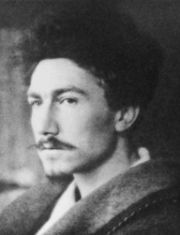
This new idiom, combined with a study of 19th-century French poetry, formed the basis of the United States input into 20th-century English-language poetic modernism. Ezra Pound ( 1885– 1972) and T. S. Eliot ( 1888– 1965) were the leading figures at the time, but numerous other poets made important contributions. These included Gertrude Stein ( 1874– 1946), Wallace Stevens ( 1879– 1955), William Carlos Williams ( 1883– 1963), Hilda Doolittle (H.D.) ( 1886– 1961), Adelaide Crapsey ( 1878- 1914), Marianne Moore ( 1887– 1972), E. E. Cummings ( 1894– 1962), and Hart Crane ( 1899– 1932). Williams was to become exemplary for many later poets because he, more than any of his peers, contrived to marry spoken American English with free verse rhythms.
While these poets were unambiguously aligned with High modernism, other poets active in the United States in the first third of the 20th century were not. Among the most important of the latter were those who were associated with what came to be known as the New Criticism. These included John Crowe Ransom ( 1888– 1974), Allen Tate ( 1899– 1979), and Robert Penn Warren ( 1905– 1989). Other poets of the era, such as Archibald MacLeish ( 1892– 1982), experimented with modernist techniques but were also drawn towards more traditional modes of writing. The modernist torch was carried in the 1930s mainly by the group of poets known as the Objectivists. These included Louis Zukofsky ( 1904– 1978), Charles Reznikoff ( 1894– 1976), George Oppen ( 1908– 1984), Carl Rakosi ( 1903– 2004) and, later, Lorine Niedecker ( 1903– 1970). Kenneth Rexroth, who was published in the Objectivist Anthology, was, along with Madeline Gleason ( 1909– 1973), a forerunner of the San Francisco Renaissance.
Many of the Objectivists came from urban communities of new immigrants, and this new vein of experience and language enriched the growing American idiom. Another source of enrichment was the emergence into the American poetic mainstream of African American poets such as Langston Hughes ( 1902– 1967) and Countee Cullen ( 1903– 1946).
World War II and after
Archibald Macleish called John Gillespie Magee, Jr. "the first poet of the war".
World War II saw the emergence of a new generation of poets, many of whom were influenced by Wallace Stevens. Richard Eberhart (born 1904), Karl Shapiro (1913–2000) and Randall Jarrell (1914–1965) all wrote poetry that sprang from experience of active service. Together with Elizabeth Bishop (1911–1979), Theodore Roethke (1908–1963) and Delmore Schwartz (1913–1966), they formed a generation of poets that in contrast to the preceding generation often wrote in traditional verse forms.
After the war, a number of new poets and poetic movements emerged. John Berryman (1914–1972) and Robert Lowell (1917–1977) were the leading lights in what was to become known as the confessional movement, which was to have a strong influence on later poets like Sylvia Plath (1932–1963) and Anne Sexton (1928–1974). Both Berryman and Lowell were closely acquainted with modernism, but were mainly interested in exploring their own experiences as subject matter and a style that Lowell referred to as "cooked", that is consciously and carefully crafted.
In contrast, the Beat poets, who included such figures as Allen Ginsberg (1926–1997), Gregory Corso (1930–2001), Joanne Kyger (born 1934), Gary Snyder (born 1930), Diane Di Prima (born 1934), Denise Levertov (1923–1997), Amiri Baraka (born 1934) and Lawrence Ferlinghetti (born 1919), were distinctly raw. Reflecting, sometimes in an extreme form, the more open, relaxed and searching society of the 1950s and 1960s, the Beats pushed the boundaries of the American idiom in the direction of demotic speech perhaps further than any other group.
Around the same time, the Black Mountain poets, under the leadership of Charles Olson (1910–1970), were working at Black Mountain College. Somewhere between raw and cooked, these poets were exploring the possibilities of open form but in a much more programmatic way than the Beats. The main poets involved were Robert Creeley (1926–2005), Robert Duncan (1919–1988), Ed Dorn (1929–1999), Paul Blackburn (1926–1971), Hilda Morley (1919–1998), John Wieners (1934–2002), and Larry Eigner (1927–1996). They based their approach to poetry on Olson's 1950 essay Projective Verse, in which he called for a form based on the line, a line based on human breath and a mode of writing based on perceptions juxtaposed so that one perception leads directly to another. Cid Corman (born 1924) and Theodore Enslin (born 1924) are often associated with this group but are perhaps more correctly viewed as direct descendants of the Objectivists.
The Beats and some of the Black Mountain poets are often considered to have been responsible for the San Francisco Renaissance. However, as previously noted, San Francisco had become a hub of experimental activity from the 1930s thanks to Rexroth and Gleason. Other poets involved in this scene included Charles Bukowski (1920–1994) and Jack Spicer (1925–1965). These poets sought to combine a contemporary spoken idiom with inventive formal experiment.
Jerome Rothenberg (born 1931) is well-known for his work in ethnopoetics, but he was also the coiner of the term " deep image". Deep image poetry is inspired by the symbolist theory of correspondences. Other poets who worked with deep image include Robert Kelly (born 1935), Diane Wakoski (born 1937) and Clayton Eshleman (born 1935).
The Small Press poets (sometimes called the mimeograph movement) are another influential and eclectic group of poets who also surfaced in the San Francisco Bay Area in the late 1950s and are still active today. Fiercely independent editors, who were also poets, edited and published low-budget periodicals and chapbooks of emerging poets who might otherwise have gone unnoticed. This work ranged from formal to experimental. Gene Fowler, A.D. Winans, Hugh Fox, Paul Foreman, John Bennett, Stephen Morse, and Judy L. Brekke are among the many poets who are still actively continuing the Small Press Poets tradition. Many have turned to the new medium of the Web for its distribution capabilities.
Just as the West Coast had the San Francisco Renaissance and the Small Press Movement, the East Coast produced the New York School. This group aimed to write poetry that spoke directly of everyday experience in everyday language and produced a poetry of urbane wit and elegance that contrasts strongly with the work of their Beat contemporaries. Leading members of the group include John Ashbery (born 1927), Frank O'Hara (1926–1966), Kenneth Koch (1925–2002), James Schuyler (1923–1991), Richard Howard (born 1929), Ted Berrigan (1934–1983), Anne Waldman (born 1945) and Bernadette Mayer (born 1945).
John Cage (1912–1992), one-time Black Mountain College resident and composer, and Jackson Mac Low (born 1922) both wrote poetry based on chance or aleatory techniques. Inspired by Zen, Dada and scientific theories of indeterminacy, they were to prove to be important influences on the 1970's U.S avant-garde.
James Merrill (1926–1995), off to the side of all these groups and very much sui generis, was a poet of great formal virtuosity and the author of the epic poem The Changing Light at Sandover (1982). The influence of Wallace Stevens is evident throughout Merrill's verse, as well as the musical precedents of German and French poetry (languages taught to Merrill by his childhood governess).
American poetry now
The last thirty years in United States poetry has seen the emergence of a number of groups and trends. It is probably too soon to judge the long-term importance of these, and what follows is merely a brief outline sketch.
The 1970s saw a revival of interest in surrealism, with the most prominent poets working in this field being Andrei Codrescu (born 1946), Russell Edson (born 1935) and Maxine Chernoff (born 1952). Performance poetry also emerged from the Beat and hippie happenings, and the talk-poems of David Antin (born 1932) and ritual events performed by Rothenberg, to become a serious poetic stance which embraces multiculturalism and a range of poets from a multiplicity of cultures. This mirrored a general growth of interest in poetry by African Americans including Gwendolyn Brooks (born 1917), Maya Angelou (born 1928), Ishmael Reed (born 1938) and Nikki Giovanni (born 1943).
The most controversial avant-garde grouping during this period has been the Language poets (or L=A=N=G=U=A=G=E poets, after the magazine that bears that name). Language-centered writing is extremely theoretical, discounting speech as the basis for verse, and dedicated to questioning the referentiality of language and the dominance of the sentence as the basic unit of syntax. The idea appears to be that language when stripped of its normal associative and denotative meanings becomes closer to the source of language and may actually provide insights that might not otherwise be possible. Those critical of the Language movement point out that taken to its logical conclusion this abandonment of sense and context creates a poetry that could be just as well be written by the proverbial infinite sized room full of monkeys with an infinite number of word processors.
The Language poets movement includes a very high proportion of women, which mirrors another general trend; the rediscovery and promotion of poetry written both by earlier and contemporary women poets. In addition to Language poets, a number of the most prominent African American poets to emerge are women, and other prominent women writers include Adrienne Rich (born 1929) and Amy Gerstler (born 1956).
The Language group also contains an unusually high proportion of academics. Poetry has tended to move more and more into the campus, with a growth in creative writing and poetics programs providing an equal growth in the number of teaching posts available to practicing poets. This increased professionalization and abundance of academic presses combined with a lack of any coherent process for critical evaluation is one of the clearest developments and one which seems likely to have unpredictable consequences for the future of poetry in the United States.
The 1980s also saw the emergence of a group of poets who became known as the New Formalists. These poets, who included Molly Peacock, Brad Leithauser, Dana Gioia and Marilyn Hacker, write in traditional forms and have declared that this return to rhyme and more fixed meters is the new avant-garde. Critics of the New Formalists have compared their traditionalism with the conservative politics of the Reagan era. It is intended as an insult.
Many poets (A growing group of poets loosely called Outlaw Poets or Small Press Poets) ignore what they see as the extremes and academic elitism of the self-proclaimed avant-garde of both poetic groups, choosing to use both traditional and experimental approaches to their work.
Concurrently, a Chicago construction worker named Marc Smith was growing bored with increasingly esoteric academic poetry readings. In 1984, at the Get Me High Lounge, Smith devised the format that has come to be known as slam poetry. A competitive poetry performance, poetry slam opened the door for a new generation of writers, spoken word performers, and audiences by emphasizing a style of writing that is edgy,topical, and easily understood.
Poetry slam has produced noted poets like Alix Olson, Taylor Mali, and Saul Williams, as well as inspired hundreds of open mics.
